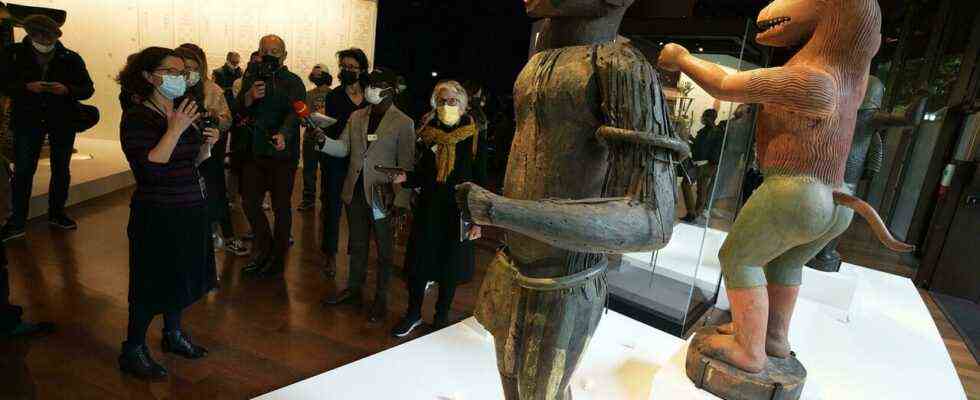Published on :
After years of controversy, the promise made by Emmanuel Macron to return to Benin 26 works of art looted by French colonial troops is about to be kept. The French president is expected at the Quai Branly museum on Wednesday for a ceremony organized on this occasion. This is the last time that these pieces, in France for 130 years, are exhibited in Paris before they are finally returned to their country of origin.
Épiphane-Basile Migan can no longer keep still as he waited for this moment. The visitor circles around art objects exhibited for the last time in France, at the Quai Branly museum, before their flight to the Benign in November.
In front of him, the royal statue called “bochio”, half-man, half-shark, of King Béhanzin, the last king of Abomey, captured by the French in 1894 and forcibly sent into exile in Martinique. The 26 works in the exhibition were part of the treasure of this sovereign, taken during the war by General Dodds who was in command during the French colonial conquest of the kingdom of Dahomey (now Benin) in 1892. “These are unique pieces in the world. , of inestimable value “, repeats Épiphane-Basile Migan, before photographing the statue of King Béhanzin from all angles, as if to miss no crumb. “You realize, we did things like that in the 19th century. Africa had a great culture. No civilization has ever done that in the world.”
This Beninese doctor, who has lived in Paris for 24 years, says he has never had the opportunity, until now, to come to see these pieces, which will find their way back to Benin on November 10. Some of them, in particular the anthropomorphic sculptures representing the kings of Abomey have had, since the promise of restitution made in 2017 in Ouagadougou by Emmanuel Macron, a prominent place in the Quai Branly museum, dominating the museum’s collection platform.
Aware of the historical dimension of the moment – one of the first restitutions by France of goods looted by its soldiers during the wars of colonization -, Épiphane-Basile Migan will return this week to show “the greatness of the kingdom of Abomey” to their children. He will also go see the works in Benin again on his next trip.
“It’s not a goodbye just a goodbye”
In a few months, these objects endowed with a very strong historical, symbolic and protective value for the Beninese population will be exhibited at the palace of the presidency of the Republic of Benin, in Cotonou, then in Ouidah in 2022, before joining the future museum. d’Abomey in 2024, the work of which has not yet been completed.
“It’s not a farewell, just a goodbye”, sums up Gaëlle Beaujon, the Africa collections manager at the Quai Branly museum. The joint teams of the Parisian museum and the Beninese curators of Ouidah and Abomey worked hand in hand to refine these preparations and the very delicate handling of these works.
“I am moved to see these well-preserved objects which will come back to us soon”, confided Abdoulaye Imorou, the curator of the site of the royal palaces of Abomey. when setting up the exhibition. It must be said that the wait was long. Benin formulated an official request for the restitution of these works in 2016. After years of controversy, the French Parliament votes in 2020 only a law authorizing France to return this spoils of war.
The return process explained to the visitor
The exhibition shows this whole process, in particular through a chronological timeline. The future of works in Benin also occupies a prominent place in the scenography, which also evokes, through a video, the conditions of the looting of the Abomey treasure, at least as far as we know. “Even today, we do not know exactly how these objects – some large ones – were moved. We have few records of what happened and we have tried to trace the history by peeling through correspondence, military testimonies… “, explains Gaëlle Beaujean.
The French state has never asked for spoils of war for this conflict, she says. But the practice was current at the time, “on the initiative of officers or non-commissioned officers present, probably however with the authorization of General Dodds”, continues the specialist who regrets that parts of this treasure are without doubt evaporated in nature.
This scientific research aiming to determine the provenance and the history of the pieces is not a detail, because France can return a work of art to the country which requests it only if these analyzes show that the work has been stolen, looted or seized. For Calixte Biah, curator of the Ouidah history museum, which will host the 26 pieces in 2022, “it would be decent for other countries which hold African pieces to follow in France’s footsteps”.
According to some specialists, nearly 90% of African heritage is still found today outside the continent.

